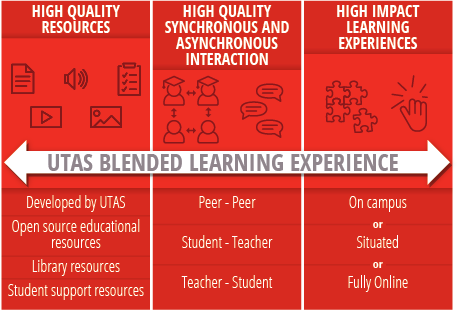Teaching & Learning
Blended Learning Model
The University of Tasmania (UTAS) Blended Learning Model aims to provide students with a learning experience that reflects their expectations of 21st century technology. Regardless of their location, timetable and mode of study, students should be able to access core information about their units and courses, communicate with teachers and peers, access high-quality resources and receive feedback on their progress.
The UTAS Blended Learning Model comprises three core features:
- a series of high-quality online resources, tailored and developed by UTAS and you as well as by the students themselves, open educational resources, and administrative and student support resources
- opportunities for synchronous and asynchronous interactions – peer to peer, student to teacher and teacher to student
- opportunities for high-impact learning, delivered on campus, as field work or practicum, or fully online.
The model also encourages sharing of academic resources and collaboration with the broader academic community.

The rationale for adopting the Blended Learning Model is outlined in the TELT White Paper [PDF] and in the accompanying background papers [PDF] which were both endorsed by Academic Senate on 15 November, 2013.
 The Blended Learning Model 1-5 Framework
The Blended Learning Model 1-5 Framework
To provide you with guidelines for the development of a high quality unit in line with this model, and with a high quality presence in MyLO, the UTAS Blended Learning Model 1-5 Framework was developed. This framework is also relevant for Teaching Performance Expectations (TPEs).
Your unit is required by the University to have a MyLO site; at a minimum it should match the description and include the features of Level 1 on the Framework. When your unit matches the level 3 description and features, it will be fully enacting the principles of the University of Tasmanian Blended Learning Model. Levels 4 and 5 require a process of peer review. The second page of the PDF contains a Quick Reference Guide, enabling you to do a check of your unit to see which features it contains, and match this to your expected level. Alternatively, you may like to check your unit with the online Blended Learning Model (BLM) Level Calculator. The BLM calculator matches the features of your unit to your expected level.
Information and support resources for using a MyLO site in your teaching can be accessed from the MyLO site Teaching Online in MyLO. Desktop Guides and other support resources are also available by searching from the University Repositories tool in MyLO.
 High Quality Resources
High Quality Resources
These resources include administrative information about your unit, such as how it has been designed, and where and when students will be expected to interact and participate in learning activities, and including information mandated by policy, rules and guidelines. Much of this foundational information is included in the Unit Outline but it is good practice to integrate some of the key information into the design of your MyLO site
The options for resources that support learning are manifold, and these options and the considerations required when selecting or developing them are explored in the Content & Resources section of this site.
To ensure that all students, regardless of location or mode of study, have access to all these resources, they need to be provided online in an accessible format. The best way of accomplishing this is through a MyLO site for your unit.
 High Quality Synchronous and Asynchronous Interaction
High Quality Synchronous and Asynchronous Interaction
Because academic success and a sense of belonging to a learning commuity is reliant upon interaction with teachers and peers, providing opportunities for peer to peer, student to teacher, and teacher to student communication is an essential element of any UTAS unit.
Students see MyLO as the communication hub for the units they study and they prefer direct interactions to be facilitated through it. This is true for all units, regardless of whether the learning activities occur online, on-campus, or situated.
Common technologies for discursive academic communication are discussions, blogs and news. It is also important to note that online communication can happen in real-time, utilising technologies such as web-conferencing, text-chat, document editing software, and VoIP.
Information about designing and managing communication and interactions in your unit can be found on the Communication page of this site.
 High Impact Learning Experiences
High Impact Learning Experiences
Teaching practices which enable student engagement and active learning are most likely to lead to student retention and success. Determining the best location or mode for students to engage in such learning activities will be dependent on the intended learning outcomes (ILOs) of the unit and the needs of the student cohort.
The high impact learning experiences will be different depending on the mode of study. For example, moving a unit to a fully online mode may use the same resources as an on-campus unit, but will be designed differently to meet the learning outcomes of the unit. Where the learning outcomes of the unit cannot be met in a fully online mode, the unit should be delivered with on-campus attendance. However, equally it may be that with the provision of high quality resources, on-campus units may not follow a traditional pattern of weekly lectures and tutorials. Instead, where appropriate they may include peer meetings, debates, panel or other activities instead of lectures, which may be delivered online (Brown, Kregor, & Williams, 2013, p.18).
Information about planning, developing and delivering high impact learning experiences can be found in the Learning Activities section of this site.
